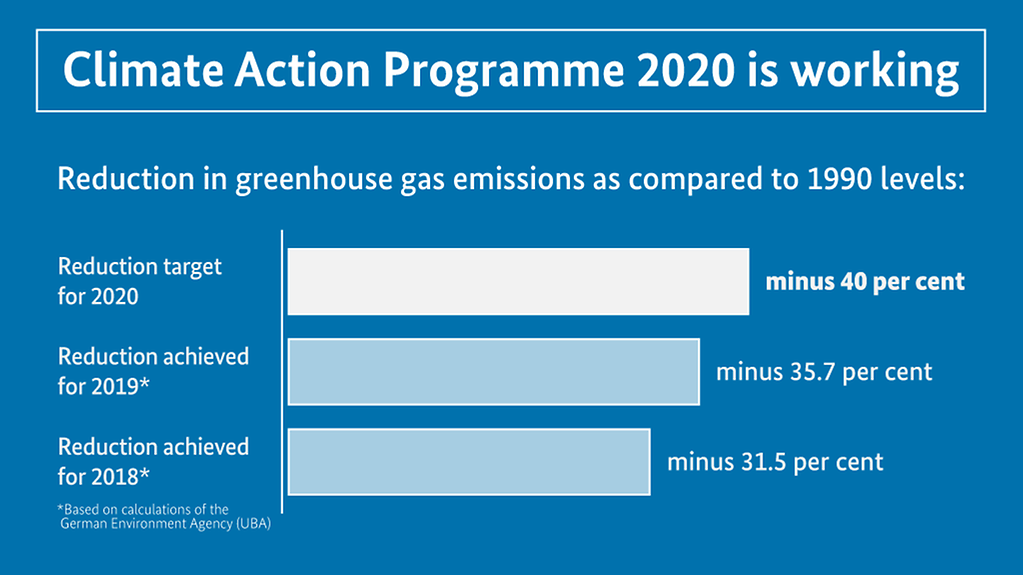FAQs on the Climate Action Report 2019
Emissions of greenhouse gases in 2019 were 35.7 per cent down on the 1990 levels. The reduction was the most marked in any year. The energy sector was responsible for the largest reduction, meaning that Germany is significantly closer to achieving its climate target for 2020 than had previously been expected. The Cabinet has adopted the Climate Action Report 2019.
4 min reading time

Effective action: the reform of emissions trading has doubled the price of CO2 emissions over the last year.
Heading: Climate Action Programme 2020 is working
Sub-heading: Reduction in greenhouse gas emissions as compared to 1990 levels
Bar chart
Three bars
First bar: Reduction target for 2020: minus 40 per cent
Second bar: Reduction achieved for 2019: minus 35.7 per cent
Third bar: Reduction achieved for 2018: minus 31.5 per cent
At bottom of diagram: Based on calculations of the German Environment Agency (UBA)
Photo: Bundesregierung
Why did emissions of greenhouse gases drop so strongly in the energy sector?
Emissions in the energy sector dropped by almost 51 million tonnes of CO2 in 2019 – the greatest contribution to reduction by a long way. One important factor was the increased prices in emissions trading, which have resulted in significantly less coal being used to generate power. Once of the central measures of the Climate Action Programme 2020 is the European emission trading scheme, which was reformed in 2018. The figures show that the new system is working. As emission allowances have become scarcer, the prices of emitting a tonne of CO2 doubled last year. On average, emitting one tonne of CO2 cost almost 25 euros.
In 2019 almost 43 per cent of power was generated from wind, solar power, hydropower or biomass, also contributing to the drop in CO2 emissions. Enhanced energy efficiency has pushed down demand for power, while modern combined heat and power systems and the gradual scaling back of the capacities of lignite-fired power stations have all done their bit.
What is the German government doing to address rising emissions in the transport sector?
CO2 emissions in the transport sector rose slightly, by 1.2 million tonnes to 163.5 million tonnes. Although more fuel-efficient vehicles are available on the market, an increasing number of vehicles and increasingly heavy vehicles are on the road (up 1.6 per cent). Overall petrol and diesel consumption has risen.
By 2030, the sector is to reduce emissions to no more than 95-98 million tonnes of CO2. To effectively reduce emissions in the transport sector, the German government is, for instance, pushing ahead with electric mobility. By 2030 at least seven million electric vehicles are to be on the roads. Parallel to this, the government is fostering the development of alternative fuels and digital transport technology. By 2030, federal government is to invest 86 billion euros in renewing the country’s rail network, while billions more will be invested in public transport in the individual federal states.
How extensive is the Climate Action Programme 2020?
The Climate Action Programme embraces more than 110 individual measures, for which the German government is providing more than 12 billion euros. Of this sum, five billion euros will be earmarked for climate-friendly construction and housing. More than 1.7 billion euros will go to the transport sector.
The German government is also fostering municipal climate action programmes through the National Climate Initiative.
Will Germany achieve the climate target for 2020?
The greenhouse gas balance for 2019 shows an encouraging drop in emissions of 35.7 per cent of the 1990 levels. For 2020, Germany has undertaken to reduce its greenhouse gas emissions by 40 per cent. The Climate Action Report 2019 indicates that the measures taken under the Climate Action Programme are working and are helping close the expected gap. Germany is far closer to achieving the 2020 target than was expected even last year.
The Climate Action Report 2019, however, does not yet cover the changed trends in emissions caused by the COVID-19 pandemic. It is currently expected that emissions will remain well below the levels predicted by forecasts and models produced before the pandemic.
What happens in the field of climate action after 2020?
In the Paris Agreement on climate change, signatory states agreed to make national contributions to climate change mitigation in order to keep global warming down to a temperature rise of 1.5° Celsius if at all possible. Germany has undertaken to reduce its greenhouse gas emissions by 55 per cent by 2030. The common goal of the German government and the EU is to become climate neutral by 2050.
What does the Climate Action Programme 2030 say?
In September 2019, the German government adopted the Climate Action Programme 2030. Many of the measures laid out in the programme are already in effect, joined most recently on 14 August 2020 by the package for ending the use of coal in power generation. National CO2 pricing for fossil fuels will begin step by step as of 2021. There is a high take-up on both the higher innovation bonus for electric vehicles and the improved support available for refurbishing buildings to enhance energy efficiency.
With the Climate Action Act (Klimaschutzgesetz) of October 2019, the German government made climate action mandatory. On 12 August it appointed the members of the independent council of experts that is to monitor progress in the different sectors. If it should become apparent that the legal mitigation targets will not be met in some sectors, the German government will take immediate corrective action.